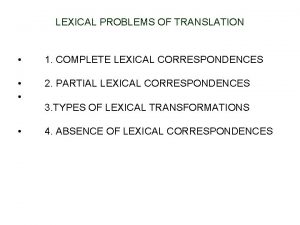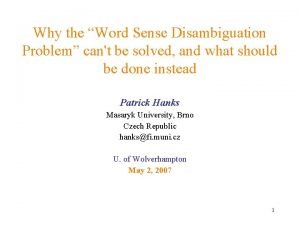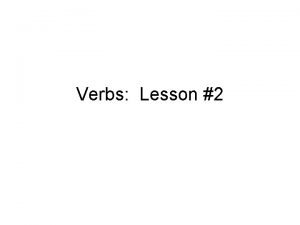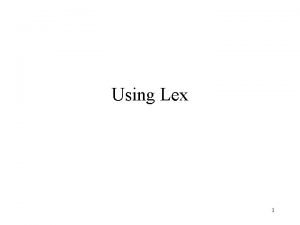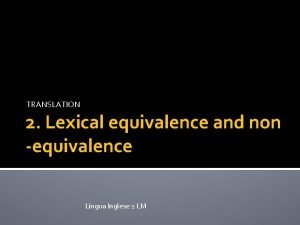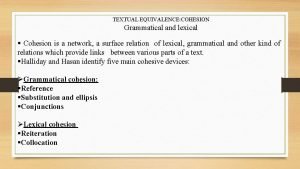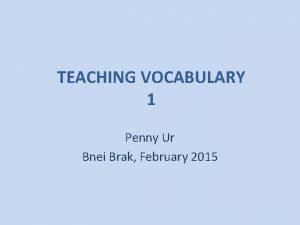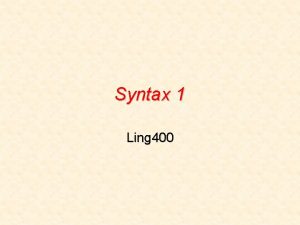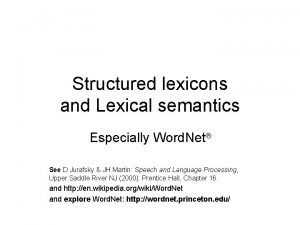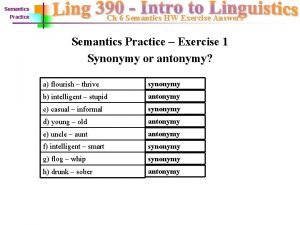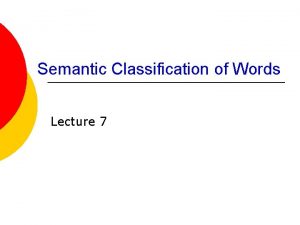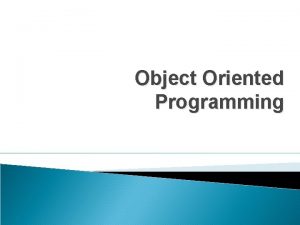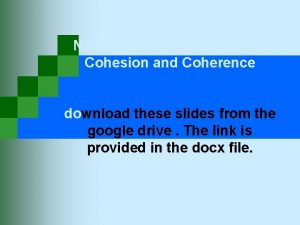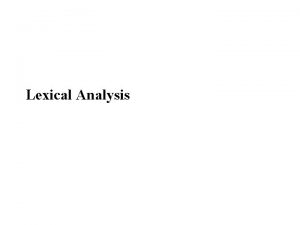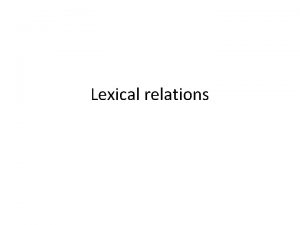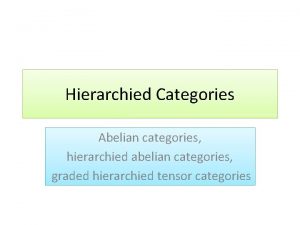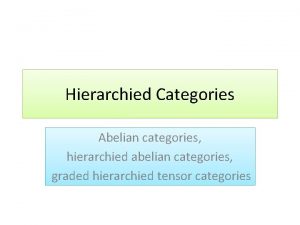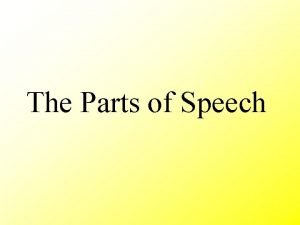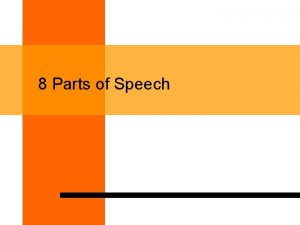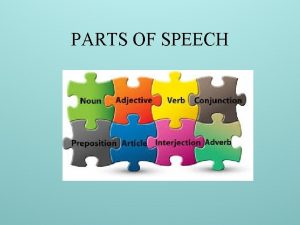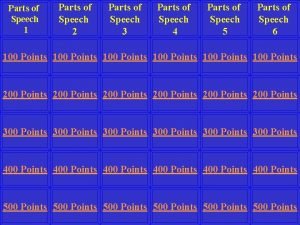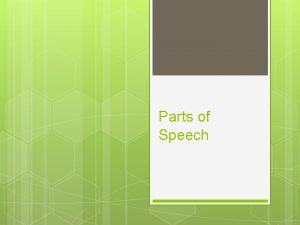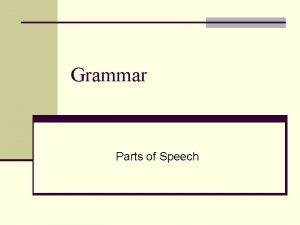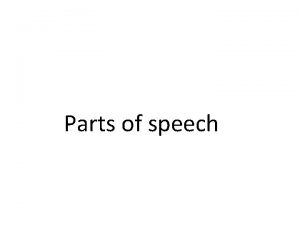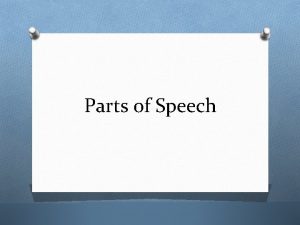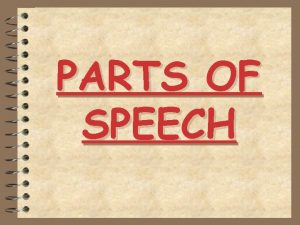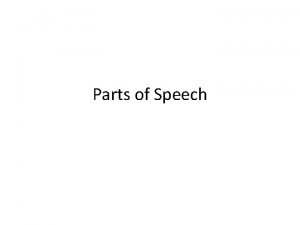Parts of Speech Lexical Categories Parts of Speech





















- Slides: 21

Parts of Speech (Lexical Categories)

Parts of Speech Nouns, Verbs, Adjectives, Prepositions, Adverbs (etc. ) The building blocks of sentences The [Nsun] shines too brightly in Tucson *[VWill glow] shines too brightly in Tucson Also called: Lexical Categories, Syntactic Categories.

Classic Definitions of P. O. S Noun: Person, Verb: Action, place, or thing occurrence or state of being Adjective: modifier that expresses quality, quantity or extent.

Classic Definitions of P. O. S Adverb: modifier that expresses manner, quality, place, time, degree, number, cause, opposition, affirmation or denial Preposition: modifier that indicates location or origin.

Problems with the semantic def. Not so clear cut: The assassination of the president… Sincerity is an important quality Tucson is where New Yorkers flee for the winter Multiple parts of speech? They cannot still her brave clear voice. [V] It was a still cold night. [A] They will dance until dawn. [V] One dance was all she would grant him. [N]

Problems with the semantic def. Cross-linguistic Problems: Direct translations changing part of speech – Irish Gaelic: a) D’ith Seán Pst’eat. 3 sng John “John ate” b) ’S-dochtúir-é Seán Pres-doctor-3 sng John “John is a doctor” (lit. John doctors)

Problems with the semantic def. Cross-linguistic Problems Kwamera – a) Iak-imiki Kuri u [verbs take tense] 1 sg. dislike dog this “I don’t like this dog” b) ianpin iak-am-óuihi [óuihi takes tense] when 1 s-prog-small still “when I was still small”

Problems with the semantic def. Cross-linguistic Problems – Warlpiri: a) Wita-rlu ka maliki wajilipinyi Small-subj aux dog chase. present “The small one is chasing the dog”

Problems with the semantic def. The yinkish dripner blorked quastofically into the nindin with the pidibs. yinkish -adj dripner -noun blorked -verb quastofically -adverb nindin -noun pidibs -noun

Distributional definitions We determine the P. O. S of a word by the affixes that are attached to it and by the syntactic context (where in the sentence) it appears in. The definition of P. O. S is distributional Because they are distributional, POS definitions are language specific.

Two kinds of distribution Morphological distribution (affixes --prefixes, suffixes etc. -- that appear on the word) Syntactic distribution (position relative to nearby words. )

P. O. S distributionally (English) Nouns take case, number and gender endings -ness, -ment, -ing, -er, etc. derivational affixes appear after [ the _____ ] can be subject/object of sentence Modified by Adjectives – – – [ a large ____ ] a large house was found a large red house was found. [_____ is a pain in the neck] Is red modified by large?

P. O. S. (classes of verbs) Main verbs versus helping verbs – – – John has been eating shrimp John may eat some shrimp. John did not eat shrimp. Technical term for helping verb: Auxiliary – – – Modal aux: may, should, can, will, would, might, … Aspectual aux: have, be Support aux: do

P. O. S distributionally (English) Verbs take -ify, -ing, re- derivational affixes takes -s, -ed, -en, -ing, inflectional affixes (can be inflected for tense, mood, aspect) appear after auxiliaries [ will ______ ] [Please _______!] follows subject and precedes object can be negated: – – He smiled. He did not smile.

P. O. S distributionally (English) Adjectives take -er, -est, -ate, -ity, -ish, -some affixes appear between ‘the’ & noun [ the _____ book ] can follow ‘very’ [very _______] can appear in [John is _____] Adverbs take -ly affix appear before adjectives and verbs [very ______] can appear at very beginning or end of sentence

Distinguish Adverbs from Adjectives? Adverbs: modify any category but nouns, never combine with -ly Adjectives: modify nouns, combine with -ly But they are in complementary distribution: – part of the same category? Also both take the same modifiers (eg. ‘very’) We’ll be agnostic on this point and abbr. both Adv & Adjs as “A”, but the jury is still out on this one.

Adverbs vs Adjectives Adverbs: take -er (more), -est (most) Adjectives: take -er (more), est(most) Both take adverbs as modifiers You generate the examples!

Cross-Linguistic Variation in POS Each language has its own set of distributional criteria. Not all languages have the same sets of parts of speech as English. Some may have less (eg. They may not distinguish verbs from adjectives) or they may have more!

Open vs. Closed P. O. S Open POS: allow neologisms (new words) express content N, V, Adj, Adv Closed POS: don’t allow new additions express function Prepositions, conjunctions, modals, auxiliaries, determiners (articles), pronouns, among others.

Some closed class POS • Prepositions (P): to, from, under, over, with, by, up, etc. • Conjunctions (Conj): and, or, either … or, • Determiners/deitics/quantifiers/numerals (D): this, that, the, a, my, your, our his, her, their, each, every, some, one, two three etc. • Complementizers (C): that, which, for, if • Auxiliaries/Modals/Tense (T): will, have, can, should, is, must, would • Negators (D) or (N): no, not, n’t, never, no-one. THIS LIST IS NOT EXHAUSTIVE!!

Summary: POS Building blocks of sentences Classic definitions are meaning-based. Linguistic definitions are distributionally based: don’t work well: unclear cases, ambiguous POS, crosslinguistic problems, knowledge of POS without knowledge of meaning morphological distribution (affixes) syntactic distribution (nearby words) Open vs. Closed classes
 Lexical problems
Lexical problems Mshsl speech categories
Mshsl speech categories Lexical sets
Lexical sets Auxiliary verb definition
Auxiliary verb definition %option noyywrap
%option noyywrap Non equivalence in translation
Non equivalence in translation The role of the lexical analyzer
The role of the lexical analyzer Lexical and syntactic ambiguity
Lexical and syntactic ambiguity What is textual equivalence
What is textual equivalence Lexical sets
Lexical sets Lexical ambiguity
Lexical ambiguity Stylistic semasiology
Stylistic semasiology Lexicon semantics
Lexicon semantics Lxical
Lxical Grammatical meaning and lexical meaning
Grammatical meaning and lexical meaning Semantics exercises with answers pdf
Semantics exercises with answers pdf Lexical sets
Lexical sets Lexical sets
Lexical sets Cratily
Cratily Example of nominal substitution
Example of nominal substitution Lexical issues in java with example
Lexical issues in java with example Coherent and cohesion meaning
Coherent and cohesion meaning
